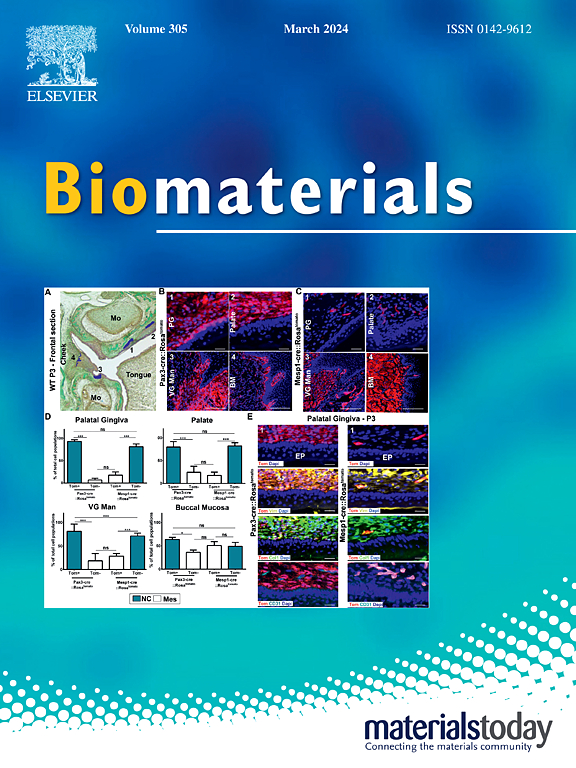Precisely deliver toll-like receptor agonists using a dual-responsive nanovaccine for effective cancer immunotherapy
IF 12.8
1区 医学
Q1 ENGINEERING, BIOMEDICAL
引用次数: 0
Abstract
Cancer vaccines have demonstrated their potential in cancer immunotherapy. However, various agonists in free form are easily to be eliminated in vivo and may cause systemic adverse effects. It remains a challenge to effectively target and release agonists at their receptor locations and prevent undesirable leakage. Herein, we present a dual-responsive nanovaccine (DRNV) for targeted delivery of toll-like receptor (TLR) agonists. DRNV was formed by self-assembly of antigen and degradable amphiphilic polymer, polyethylene glycol modified poly (lipoic acid) (PTA). Imidazoquinoline (IMDQ), a classical TLR7/8 agonist, was covalently conjugated to PTA with an enzyme-responsive linker. With this design, DRNV can avoid rapid elimination and potential toxicity due to systemic diffusion. Furthermore, the PTA core would be quickly degraded in response to intracellular glutathione, leading to the disintegration of DRNV and promoting enzyme-responsive release of IMDQ, ultimately stimulating TLR7/8 receptors on the inner membrane of endosomes. Systemic animal experiments demonstrated that DRNV effectively inhibits tumor growth and triggers protective antitumor immune responses to against tumor rechallenge and metastasis. Overall, this work demonstrates a feasible nanoplatform for the precise delivery of TLR agonists and tumor antigens, providing insights into the design of advanced nanovaccine for effective and safe cancer immunotherapy.

使用双反应纳米疫苗精确递送toll样受体激动剂,用于有效的癌症免疫治疗
癌症疫苗在癌症免疫治疗中已显示出其潜力。然而,各种自由形式的激动剂很容易在体内被消除,并可能引起全身不良反应。它仍然是一个挑战,有效地靶向和释放受体位置的激动剂和防止不良泄漏。在此,我们提出了一种双反应纳米疫苗(DRNV),用于靶向递送toll样受体(TLR)激动剂。DRNV是由抗原与可降解的两亲性聚合物聚乙二醇修饰聚硫辛酸(PTA)自组装而成。咪唑喹啉(IMDQ)是一种经典的TLR7/8激动剂,通过酶应答连接物与PTA共价偶联。通过这种设计,DRNV可以避免快速消除和由于全身扩散而产生的潜在毒性。此外,PTA核心会在细胞内谷胱甘肽的作用下迅速降解,导致DRNV解体,促进IMDQ的酶响应性释放,最终刺激核内体内膜上的TLR7/8受体。系统动物实验表明,DRNV能有效抑制肿瘤生长,引发保护性抗肿瘤免疫反应,抵抗肿瘤再攻击和转移。总的来说,这项工作为精确递送TLR激动剂和肿瘤抗原提供了一个可行的纳米平台,为设计有效和安全的癌症免疫治疗的高级纳米疫苗提供了见解。
本文章由计算机程序翻译,如有差异,请以英文原文为准。
求助全文
约1分钟内获得全文
求助全文
来源期刊

Biomaterials
工程技术-材料科学:生物材料
CiteScore
26.00
自引率
2.90%
发文量
565
审稿时长
46 days
期刊介绍:
Biomaterials is an international journal covering the science and clinical application of biomaterials. A biomaterial is now defined as a substance that has been engineered to take a form which, alone or as part of a complex system, is used to direct, by control of interactions with components of living systems, the course of any therapeutic or diagnostic procedure. It is the aim of the journal to provide a peer-reviewed forum for the publication of original papers and authoritative review and opinion papers dealing with the most important issues facing the use of biomaterials in clinical practice. The scope of the journal covers the wide range of physical, biological and chemical sciences that underpin the design of biomaterials and the clinical disciplines in which they are used. These sciences include polymer synthesis and characterization, drug and gene vector design, the biology of the host response, immunology and toxicology and self assembly at the nanoscale. Clinical applications include the therapies of medical technology and regenerative medicine in all clinical disciplines, and diagnostic systems that reply on innovative contrast and sensing agents. The journal is relevant to areas such as cancer diagnosis and therapy, implantable devices, drug delivery systems, gene vectors, bionanotechnology and tissue engineering.
 求助内容:
求助内容: 应助结果提醒方式:
应助结果提醒方式:


